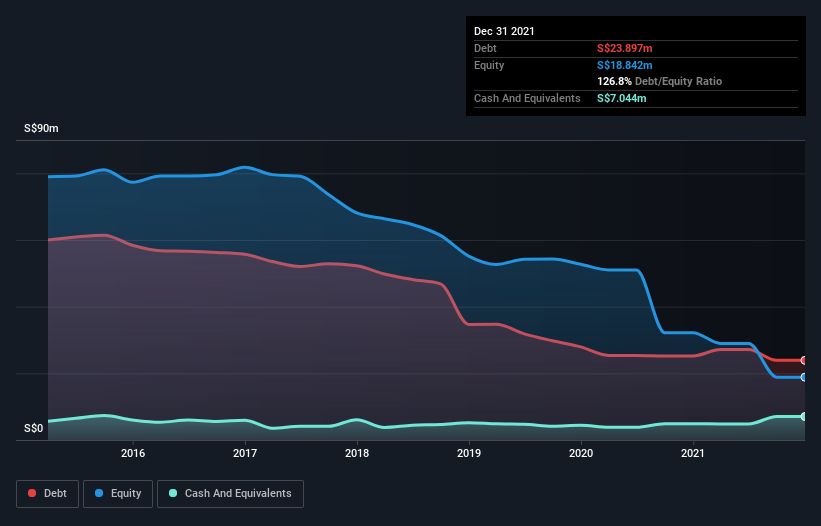The external fund manager backed by Berkshire Hathaway's Charlie Munger, Li Lu, makes no bones about it when he says 'The biggest investment risk is not the volatility of prices, but whether you will suffer a permanent loss of capital.' It's only natural to consider a company's balance sheet when you examine how risky it is, since debt is often involved when a business collapses. We can see that Beng Kuang Marine Limited (SGX:BEZ) does use debt in its business. But the real question is whether this debt is making the company risky.
What Risk Does Debt Bring?
Debt assists a business until the business has trouble paying it off, either with new capital or with free cash flow. If things get really bad, the lenders can take control of the business. However, a more common (but still painful) scenario is that it has to raise new equity capital at a low price, thus permanently diluting shareholders. By replacing dilution, though, debt can be an extremely good tool for businesses that need capital to invest in growth at high rates of return. When we examine debt levels, we first consider both cash and debt levels, together.
View our latest analysis for Beng Kuang Marine
What Is Beng Kuang Marine's Net Debt?
The image below, which you can click on for greater detail, shows that Beng Kuang Marine had debt of S$23.9m at the end of December 2021, a reduction from S$25.2m over a year. However, because it has a cash reserve of S$7.04m, its net debt is less, at about S$16.9m.

How Healthy Is Beng Kuang Marine's Balance Sheet?
The latest balance sheet data shows that Beng Kuang Marine had liabilities of S$53.3m due within a year, and liabilities of S$7.26m falling due after that. Offsetting this, it had S$7.04m in cash and S$27.5m in receivables that were due within 12 months. So its liabilities total S$26.1m more than the combination of its cash and short-term receivables.
This deficit casts a shadow over the S$14.9m company, like a colossus towering over mere mortals. So we'd watch its balance sheet closely, without a doubt. After all, Beng Kuang Marine would likely require a major re-capitalisation if it had to pay its creditors today. When analysing debt levels, the balance sheet is the obvious place to start. But it is Beng Kuang Marine's earnings that will influence how the balance sheet holds up in the future. So when considering debt, it's definitely worth looking at the earnings trend. Click here for an interactive snapshot.
Over 12 months, Beng Kuang Marine reported revenue of S$53m, which is a gain of 24%, although it did not report any earnings before interest and tax. Shareholders probably have their fingers crossed that it can grow its way to profits.
Caveat Emptor
Despite the top line growth, Beng Kuang Marine still had an earnings before interest and tax (EBIT) loss over the last year. Indeed, it lost a very considerable S$8.6m at the EBIT level. When we look at that alongside the significant liabilities, we're not particularly confident about the company. We'd want to see some strong near-term improvements before getting too interested in the stock. It's fair to say the loss of S$13m didn't encourage us either; we'd like to see a profit. In the meantime, we consider the stock to be risky. There's no doubt that we learn most about debt from the balance sheet. However, not all investment risk resides within the balance sheet - far from it. For example Beng Kuang Marine has 4 warning signs (and 1 which shouldn't be ignored) we think you should know about.
If you're interested in investing in businesses that can grow profits without the burden of debt, then check out this free list of growing businesses that have net cash on the balance sheet.
Valuation is complex, but we're here to simplify it.
Discover if Beng Kuang Marine might be undervalued or overvalued with our detailed analysis, featuring fair value estimates, potential risks, dividends, insider trades, and its financial condition.
Access Free AnalysisHave feedback on this article? Concerned about the content? Get in touch with us directly. Alternatively, email editorial-team (at) simplywallst.com.
This article by Simply Wall St is general in nature. We provide commentary based on historical data and analyst forecasts only using an unbiased methodology and our articles are not intended to be financial advice. It does not constitute a recommendation to buy or sell any stock, and does not take account of your objectives, or your financial situation. We aim to bring you long-term focused analysis driven by fundamental data. Note that our analysis may not factor in the latest price-sensitive company announcements or qualitative material. Simply Wall St has no position in any stocks mentioned.
About SGX:BEZ
Beng Kuang Marine
An investment holding company, provides infrastructure engineering and corrosion prevention services in Singapore, Asia, Europe, the Middle East, and internationally.
Flawless balance sheet and good value.
Market Insights
Community Narratives




